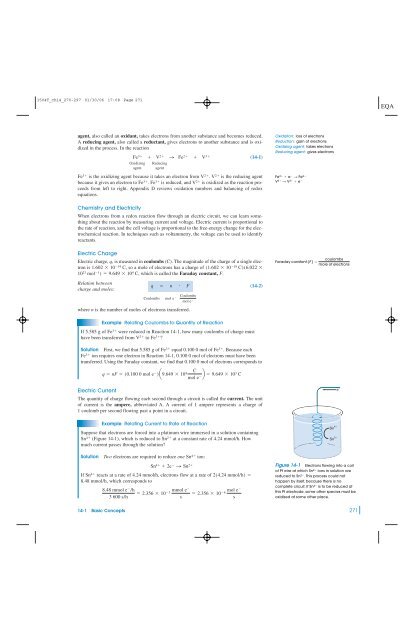Fundamentals of Electrochemistry - W.H. Freeman
Fundamentals of Electrochemistry - W.H. Freeman
Fundamentals of Electrochemistry - W.H. Freeman
Create successful ePaper yourself
Turn your PDF publications into a flip-book with our unique Google optimized e-Paper software.
1504T_ch14_270-297 01/30/06 17:08 Page 271<br />
agent, also called an oxidant, takes electrons from another substance and becomes reduced.<br />
A reducing agent, also called a reductant, gives electrons to another substance and is oxidized<br />
in the process. In the reaction<br />
Fe 3 V 2 S Fe 2 V 3<br />
Oxidizing Reducing<br />
agent agent<br />
(14-1)<br />
Fe 3 is the oxidizing agent because it takes an electron from V 2 . V 2 is the reducing agent<br />
because it gives an electron to Fe 3 . Fe 3 is reduced, and V 2 is oxidized as the reaction proceeds<br />
from left to right. Appendix D reviews oxidation numbers and balancing <strong>of</strong> redox<br />
equations.<br />
Oxidation: loss <strong>of</strong> electrons<br />
Reduction: gain <strong>of</strong> electrons<br />
Oxidizing agent: takes electrons<br />
Reducing agent: gives electrons<br />
Fe 3 e S Fe 2<br />
V 2 S V 3 e <br />
Chemistry and Electricity<br />
When electrons from a redox reaction flow through an electric circuit, we can learn something<br />
about the reaction by measuring current and voltage. Electric current is proportional to<br />
the rate <strong>of</strong> reaction, and the cell voltage is proportional to the free-energy change for the electrochemical<br />
reaction. In techniques such as voltammetry, the voltage can be used to identify<br />
reactants.<br />
Electric Charge<br />
Electric charge, q, is measured in coulombs (C). The magnitude <strong>of</strong> the charge <strong>of</strong> a single electron<br />
is 1.602 10 19 C, so a mole <strong>of</strong> electrons has a charge <strong>of</strong> (1.602 10 19 C)(6.022 <br />
10 23 mol 1 ) 9.649 10 4 C, which is called the Faraday constant, F.<br />
coulombs<br />
Faraday constant (F ) <br />
mole <strong>of</strong> electrons<br />
Relation between<br />
charge and moles:<br />
q n F<br />
Coulombs<br />
mol e <br />
Coulombs<br />
mol e <br />
where n is the number <strong>of</strong> moles <strong>of</strong> electrons transferred.<br />
(14-2)<br />
Example Relating Coulombs to Quantity <strong>of</strong> Reaction<br />
Fe 3<br />
If 5.585 g <strong>of</strong> were reduced in Reaction 14-1, how many coulombs <strong>of</strong> charge must<br />
have been transferred from V 2 to Fe 3 ?<br />
Solution First, we find that 5.585 g <strong>of</strong> Fe 3 equal 0.100 0 mol <strong>of</strong> Fe 3 . Because each<br />
Fe 3 ion requires one electron in Reaction 14-1, 0.100 0 mol <strong>of</strong> electrons must have been<br />
transferred. Using the Faraday constant, we find that 0.100 0 mol <strong>of</strong> electrons corresponds to<br />
C<br />
q nF (0.100 0 mol e ) a9.649 10 4 mol e b 9.649 103 C<br />
Electric Current<br />
The quantity <strong>of</strong> charge flowing each second through a circuit is called the current. The unit<br />
<strong>of</strong> current is the ampere, abbreviated A. A current <strong>of</strong> 1 ampere represents a charge <strong>of</strong><br />
1 coulomb per second flowing past a point in a circuit.<br />
Example Relating Current to Rate <strong>of</strong> Reaction<br />
Suppose that electrons are forced into a platinum wire immersed in a solution containing<br />
Sn 4 (Figure 14-1), which is reduced to Sn 2 at a constant rate <strong>of</strong> 4.24 mmol/h. How<br />
much current passes through the solution?<br />
Solution Two electrons are required to reduce one ion:<br />
If Sn 4 reacts at a rate <strong>of</strong> 4.24 mmol/h, electrons flow at a rate <strong>of</strong> 2(4.24 mmol/h) <br />
8.48 mmol/h, which corresponds to<br />
8.48 mmol e /h<br />
3 600 s/h<br />
Sn 4<br />
Sn 4 2e S Sn 2<br />
mmol e<br />
mol e<br />
2.356 103 2.356 106 s<br />
s<br />
Sn 4+<br />
Sn 2+<br />
Figure 14-1 Electrons flowing into a coil<br />
<strong>of</strong> Pt wire at which Sn 4 ions in solution are<br />
reduced to Sn 2 . This process could not<br />
happen by itself, because there is no<br />
complete circuit. If Sn 4 is to be reduced at<br />
this Pt electrode, some other species must be<br />
oxidized at some other place.<br />
e –<br />
14-1 Basic Concepts 271

















